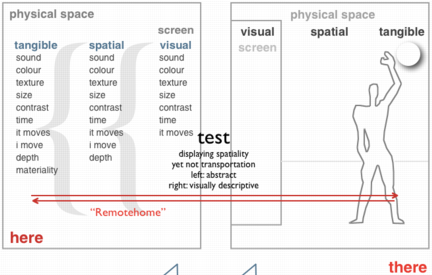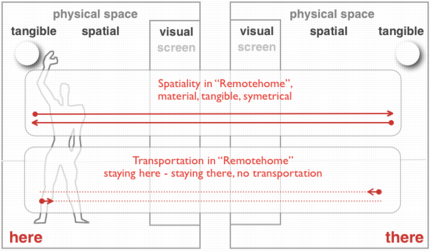
Transportation and Artificiality classification by Benford et.al. 1998
Telepresence / TelematicsAs described by Benford[1] (et.al.) the dimensions of transportation, artificiality and spatiality play a key role in visitors experience of telepresence systems. Transportation determines “the extent to which a group of participants [...] leave behind their local space and enter into some new remote space [...], versus the extent to which they remain in their local space and the remote participants [...] are brought to them. It therefore characterizes the essential difference between the concepts of local and remote.”[1] These dimensions also play a vital role in the perception of immersive environments, as “like immersion, transportation is in principle a quantifiable property of technology.” Sheridan (in Benford) [2] The following graphics were informed by this and show the degree of “transformation” for some examples of interactive environments. |
|||
|
The term Telepresence was coined in 1980 by Marvin Minsky and Pat Gunkel. It referred to the “phenomenon that a human operator develops a sense of being physically present at a remote location through interaction with the system’s human interface, i.e. through the user’s actions and subsequent perceptual feedback he/she receives via the teleoperational technology” (IJsselsteijn, 2000) more recently its meaning has changed somewhat and it is less about the perception of leaving the local space behind but is more generally understood as “the union of telematics and elements of remote physical action.” (Kac, 2005,193) Stephen Wilson also has a wider definition and suggests that “every kind of telecommunications is telepresence - a technology for a person to be present in some form in a distant place” (Wilson, 2002, 526) adding that email was telepresent to an extent. Brenda Laurel and Scott Fisher define it as a technology ”that enables people to feel as if they were actually present at a different place or time,” (Wilson, 2002, 527) a definition that includes the change of the spatial properties of a local environment as telematic data is augmented and would thus pertain to Radiomap. For Rosenberg or Sheridan (Wilson, 2002, 527) telepresence is not complete without the ability to act at the remote location, something other researchers would define as teleoperation. |
|||
Transportation, Spatiality and TransformationVisualized below is a schematic diagram with which interactive installations or environments that transform information and/or connect two or more places to one another can be depicted. The degree of spatiality is shown as whether the data is “manifested” on a screen only, or creating changes in the “real world”. It also clearly displays to which degree actions in the “real world” create changes on the network or remote output devices. Some connections are ‘one-way” only, others bi-directional. There are four basic possibilities: 1) connections from the real world to the real world, 2) connections from screen based applications to screen based applications; 3) from the real world to the screen 4) from the screen to the real world. Mixes of the above, installations that visualize network processes and don’t connect any “places” with one another may also be depicted in this diagram. Transformation & Spatiality in simple telematic setup's

|
|||
Spatiality/ TestGraphic is displaying Spatiality but not Transportation. 
|
|||
Transportation / Spatiality TestThis graphic is a strange mix of visual description - and abstract overlay. The underlying layer is almost redundant ... 
|
|||
What is the relationship between artificiality and transformation? |
|||
Telematics: The dialogical vs. data transfer Today we are sourrounded by "telepresence" devices yet usually not very aware of this aspect of their existence. They simply allow us to connect to absent people, friends and family. Becoming aware of this telepresence without telepresence effects early in my research I could not make much sense of it. Its synchronous or asynchronous (as in phone vs. email) symmetrical or asymmetrical (as in speaking at the same time or having to wait; video chat with someone with only an audio connection). Live data or stored data. |
|||
|
4. Design theorist John Thackara also acknowledges the importance of telematic technologies in contemporary media art, emphasising the close relationship between media art and network art. He adds that they had two crucial roles to play. First, their content “can draw attention to phenomena in our world that exist, but are not seen - the hidden forces [...], Second, media art can teach us new processes of collaborative enquiry.” (Thackara, 2006, 183-184) For him this “new art is collaborative and interactive” in that it brings people together to communicate, the artist facilitating this dialogue. He does not refer though to the purpose of the art to create a critical awareness of technology. |
|||
| last update: 10/26/02008 13:08 About Contact Disclaimer Glossary Index |
|||
